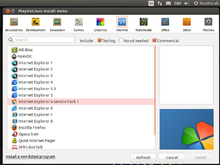Wine (software)
Wine[a] is a free and open-source compatibility layer to allow application software and computer games developed for Microsoft Windows to run on Unix-like operating systems.In a 2007 survey by desktoplinux.com of 38,500 Linux desktop users, 31.5% of respondents reported using Wine to run Windows applications.[11] Wine originally targeted 16-bit applications for Windows 3.x, but as of 2010[update] focuses on 32-bit and 64-bit versions which have become the standard on newer operating systems.Wine-staging is an independently maintained set of aggressive patches not deemed ready by WineHQ developers for merging into the Wine repository, but still considered useful by the wine-compholio fork.CrossOver includes some application-specific tweaks not considered suitable for the upstream version, as well as some additional proprietary components.[27] Valve works with CodeWeavers to develop Proton, a Wine-based compatibility layer for Microsoft Windows games to run on Linux-based operating systems.These contain a huge number of wrapper sub-routines for the system calls of the kernel, the NTOS kernel-mode program (ntoskrnl.exe).The system-call layer is considered private to Microsoft programmers as documentation is not publicly available, and published interfaces all rely on subsystems running on top of the kernel.[29] Wine implements the Windows application binary interface (ABI) entirely in user space, rather than as a kernel module.Its built-in implementation of the most basic Windows DLLs, namely NTDLL, KERNEL32, GDI32, and USER32, uses the shared object method because they must use functions in the host operating system as well.In this case, the Gallium3D layer allows a direct pass-through of DX9 drawing commands which results in performance improvements of up to a factor of 2.While this approach focuses Wine development on long-term compatibility, it makes it difficult for users to run applications that require workarounds.[43] The developers of the Direct3D portions of Wine have continued to implement new features such as pixel shaders to increase game support.The two versions of Wine are built separately, and as a result only building wine64 produces an environment only capable of running x86-64 applications.[68] Wine provides Winelib, which allows its shared-object implementations of the Windows API to be used as actual libraries for a Unix program.[71] On 3 February 2013 at the FOSDEM talk in Brussels, Alexandre Julliard demonstrated an early demo of Wine running on Google's Android operating system.[73] Wine, by default, uses specialized Windows builds of Gecko and Mono to substitute for Microsoft's Internet Explorer and .NET Framework.Winetricks offer auto-installation for Internet Explorer 6 through 8, so these versions can be reasonably expected to work with its built-in workarounds.The core Wine development aims at a correct implementation of the Windows API as a whole and has sometimes lagged in some areas of compatibility with certain applications.[79] CodeWeavers markets CrossOver specifically for running Microsoft Office and other major Windows applications, including some games.CodeWeavers also released a new version called CrossOver Mac for Intel-based Apple Macintosh computers on 10 January 2007.An alternative to improve the security without the performance cost of using a virtual machine, is to run Wine in an LXC container, as Anbox software is doing by default with Android.[115][116] A common concern about Wine is that its existence means that vendors are less likely to write native Linux, macOS, and BSD applications.An article describes the weaknesses of OS/2 which killed it, the first one being: OS/2 offered excellent compatibility with DOS and Windows 3.1 applications.Perhaps the most serious was that most computers sold already came with DOS and Windows, and many people didn't bother to evaluate OS/2 on its merits due to already having an operating system."Bundling" of DOS and Windows and the chilling effect this had on the operating system market frequently came up in United States v. Microsoft Corporation.However, now it can run Microsoft Office, multimedia applications such as QuickTime and Windows Media Player, and even games such as Max Payne or Unreal Tournament 3.

Software works flawlessly
Software works flawlessly after configuration
Minor problems with the software
Major problems with the software
Completely non-functional software


Original author(s)Developer(s)Stable releaseRepositoryOperating systemFreeBSDReactOSAndroidPlatformx86-64Compatibility layerLicenseLGPL 2.1 or laterfree and open-sourceapplication softwarecomputer gamesMicrosoft WindowsUnix-likeoperating systemscompileblack-box testingcopyrightcode emulationvirtualizationx86 virtualizationSun MicrosystemsSolarisPublic Windows InterfaceWindows APIMicrosoftWindows 3.xUsenetAlexandre Julliarddocumentationfunctionsfile formatsprotocolsreverse-engineeredthunkingMIT LicenseproprietarypatchesCodeWeaversCrossOverupstreamCorel LinuxGooglePicasaAdobe Photoshop CS2Summer of CodeProtonLinux gamingWindows APIsdynamic-link librariesapplication binary interfaceuser spacekernel moduledaemonX Window SystemsignalsWindows kernelshared objectsWindows DLLsKERNEL32USER32unit testingDirectXVulkan APIMetal APIMoltenVKXAudio2game controllersDirectDrawOpenGLOverwatchGallium3DregeditPlayOnLinuxworkaroundsout of the boxscriptWine-DoorsIEs4LinuxPlayOnMacLutrisOpenIndianaLibadwaitaDirect3Dpixel shadersNotepadWordPadControl PanelInternet ExplorerWindows Explorerbackward compatibilityWindows 3.1xWindows 2.0Windows 1.x16-bitWineVDMconsole applicationscurses64-bitMS-DOSDOSBoxWindows RTWindows CEpre-alphaSolitaire.NET FrameworkJScriptVBScriptGoogle ChromeCrossOver (software)Microsoft OfficeApple Macintoshvideo gamesProton (software)SteamOSSteam MachineVulkanWINE@EtersoftRussian1C CompanyWindows NTWindows 2000
